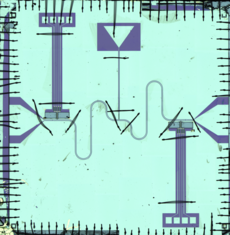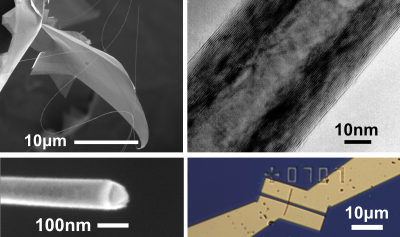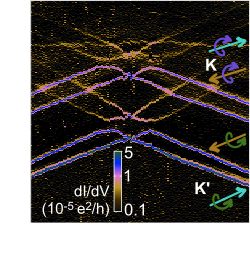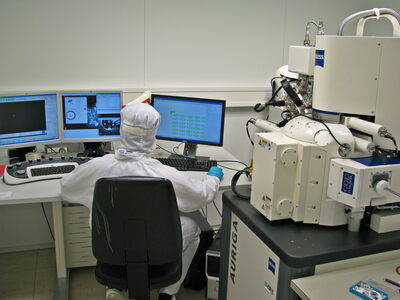main page
research
publications
team
news
contact
teaching
jobs
picture gallery
alumni
internal wiki
research group
prof. (em.) D. Weiss
research group
prof. F. Kuemmeth



research projects
nano-electromechanics of the transversal carbon nanotube vibration
 attached (clamped) to the chip substrate on one or on both ends.
Top-down lithographic fabrication of beam resonators from metals or semiconductor materials as e.g.
GaAs or silicon has led to resonator frequencies in the MHz regime. However, miniaturization has been
accompanied with high dissipation losses - due to e.g. surface, clamping, or intrinsic friction effects.
attached (clamped) to the chip substrate on one or on both ends.
Top-down lithographic fabrication of beam resonators from metals or semiconductor materials as e.g.
GaAs or silicon has led to resonator frequencies in the MHz regime. However, miniaturization has been
accompanied with high dissipation losses - due to e.g. surface, clamping, or intrinsic friction effects.
Single-wall carbon nanotubes can also be used as nanomechanical resonators, as e.g. a vibrating violin string [1-5].
Since the nanotubes are very light and mechanically very strong at the same time, they
vibrate at very high frequencies (typically the fundamental resonance mode reaches ca. 100-400 MHz).
The vibrational energy quantum then exceeds kBT in our millikelvin measurement setup.
In addition, the low mass leads to comparatively large quantum effects. For example, even if the nanotube is
in its ground state of motion, i.e. at lowermost kinetical  energy, one expects a zero point position fluctuation of approximately 1pm.
energy, one expects a zero point position fluctuation of approximately 1pm.
In order to be able to control and manipulate the nanotube vibration, we have built up techniques to couple suspended nanotube quantum dots to superconducting coplanar microwave resonators [6-9]. With that, we have been able to demonstrate optomechanical coupling of the microwave field and the vibration, strongly enhanced by the quantization of the electric charge [9].
Now, we intend to build on these results and extend them, making CNTs a unique system where single electron tunneling, discrete well-defined electronic states, and microwave opto- mechanics coherently interact. The quantum dot – microwave cavity combination is a highly versatile tool with large potential for further improvement, as truly quantum-mechanical NEMS system and "switchboard" for quantum information.
transition metal dichalcogenide nanotubes as semiconductors and superconductors
 Research on the quantum properties of quasi-two dimensional, planar transition metal dichalcogenides (TMDCs)
has already attracted huge attention worldwide. However, even though their first synthesis was already nearly
30 years ago [10, 11], not much is known on the transport properties of
TMDC nanotubes yet. First works from Japan [12, 13] show highly promising results on
intrinsic superconductivity of the nanotubes at strong ionic doping, and we have recently published first
data on the nanotubes as quantum dots [14].
Research on the quantum properties of quasi-two dimensional, planar transition metal dichalcogenides (TMDCs)
has already attracted huge attention worldwide. However, even though their first synthesis was already nearly
30 years ago [10, 11], not much is known on the transport properties of
TMDC nanotubes yet. First works from Japan [12, 13] show highly promising results on
intrinsic superconductivity of the nanotubes at strong ionic doping, and we have recently published first
data on the nanotubes as quantum dots [14].Here, we will investigate semiconducting and superconducting properties of different nanotube materials, starting with MoS2. This means on the one hand the transport spectroscopy of discrete quantum states, on the other hand the properties of the nanotube as quasi-one dimensional, tubular superconductor. Since strong spin-orbit interaction is known to be present in TMDCs, this opens up exciting perspectives towards topological superconductivity and Majorana zero modes, as are already investigated in other one-dimensional material systems.
structure and low-energy quantum states of ultraclean carbon nanotubes
 Over the past years we have collected a lot of experience with highly clean
carbon nanotube devices, where the macromolecule is grown after all other
fabrication steps are complete [15]. Here, the quantum mechanical properties of
electrons in a potential well within the nanotube become clearly visible, and
the interaction between molecular structure, i.e. nanotube chirality, and
low-energy excitations of the electronic system, i.e., the transport spectrum,
can be researched [16-18]. While this is not the main focus of the group
anymore, it provides a fascinating research topic where many fundamental
questions still need to be solved.
Over the past years we have collected a lot of experience with highly clean
carbon nanotube devices, where the macromolecule is grown after all other
fabrication steps are complete [15]. Here, the quantum mechanical properties of
electrons in a potential well within the nanotube become clearly visible, and
the interaction between molecular structure, i.e. nanotube chirality, and
low-energy excitations of the electronic system, i.e., the transport spectrum,
can be researched [16-18]. While this is not the main focus of the group
anymore, it provides a fascinating research topic where many fundamental
questions still need to be solved.A particularly interesting approach is here to conduct transport measurements on ultraclean nanotubes of known chirality, something that has been attempted in the past but only yielded limited results so far.
equipment
 The department for physics of micro- and nanostructures runs a nanofabrication
and characterization facility. In this cleanroom and in additional lab space we
have access to a wide spectrum of equipment. This ranges e.g. on the
fabrication side from optical and electron beam lithography to dry etching and
wire bonding. In addition, we collaborate with the OTH Regensburg, where
further nanofabrication is possible.
The department for physics of micro- and nanostructures runs a nanofabrication
and characterization facility. In this cleanroom and in additional lab space we
have access to a wide spectrum of equipment. This ranges e.g. on the
fabrication side from optical and electron beam lithography to dry etching and
wire bonding. In addition, we collaborate with the OTH Regensburg, where
further nanofabrication is possible.
Concerning low-temperature measurement setups, we have a 3He/4He dilution refrigerator capable of reaching a steady-state temperature of 8mK, and electronic measurement equipment ranging from low-noise dc amplifiers all the way to 20GHz vector network analyzers. In addition, we closely collaborate with the group Prof. C. Strunk, where several more low temperature setups exist. With the recent installation of a new helium liquefier at the department, optimal conditions for future extension of our low-temperature activities exist.
literature links
- V. Sazonova, Y. Yaish, H. Ustunel, D. Roundy, T. A. Arias, and P. L. McEuen, Nature 431, 284 (2004)
- B. Witkamp, M. Poot, and H. S. J. van der Zant, Nano Letters 6, 2904 (2006)
- A. K. Hüttel, G. A. Steele, B. Witkamp, M. Poot, L. P. Kouwenhoven, and H. S. J. van der Zant, Nano Letters 9, 2547 (2009) (PDF, supplementary information)
- G. A. Steele, A. K. Hüttel, B. Witkamp, M. Poot, H. B. Meerwaldt, L. P. Kouwenhoven, and H. S. J. van der Zant, Science 325, 1103 (2009) (PDF, supplementary information)
- K. J. G. Götz, S. Blien, P. L. Stiller, O. Vavra, T. Mayer, T. Huber, T. N. G. Meier, M. Kronseder, Ch. Strunk, and A. K. Hüttel, Nanotechnology 27, 135202 (2016) (PDF)
- S. Blien, K. J. G. Götz, P. L. Stiller, T. Mayer, T. Huber, O. Vavra, and A. K. Hüttel, Physica Status Solidi B 253, 2385 (2016) (PDF)
- S. Blien, P. Steger, A. Albang, N. Paradiso, and A. K. Hüttel, Physica Status Solidi B 255, 1800118 (2018) (PDF)
- S. Blien, P. Steger, N. Hüttner, R. Graaf, and A. K. Hüttel, Nature Communications 11, 1636 (2020) (PDF)
- R. Tenne, L. Margulis, M. Genut, and G. Hodes, Nature 360, 444 (1992)
- M. Remskar, A. Mrzel, Z. Skraba, A. Jesih, M. Ceh, J. Demsar, P. Stadelmann, F. Levy, and D. Mihailovic, Science 292, 479 (2001)
- F. Qin, W. Shi, T. Ideue, M. Yoshida, A. Zak, R. Tenne, T. Kikitsu, D. Inoue, D. Hashizume, and Y. Iwasa, Nature Communications 8, 14465 (2017)
- F. Qin, T. Ideue, W. Shi, X.-X. Zhang, M. Yoshida, A. Zak, R. Tenne, T. Kikitsu, D. Inoue, D. Hashizume, and Y. Iwasa, Nano Letters 18, 6789 (2018)
- S. Reinhardt, L. Pirker, C. Bäuml, M. Remskar, and A. K. Hüttel, Physica Status Solidi RRL 13, 1900251 (2019) (PDF)
- J. Cao, Q. Wang, and H. Dai, Nature Materials 4, 745 (2005)
- A. Dirnaichner, M. del Valle, K. J. G. Götz, F. J. Schupp, N. Paradiso, M. Grifoni, Ch. Strunk, and A. K. Hüttel, Physical Review Letters 117, 166804 (2016) (PDF)
- M. Marganska, D. R. Schmid, A. Dirnaichner, P. L. Stiller, Ch. Strunk, M. Grifoni, and A. K. Hüttel, Physical Review Letters 122, 086802 (2019) (PDF)
- P. L. Stiller, A. Dirnaichner, D. R. Schmid, and A. K. Hüttel, submitted for publication, arXiv:1812.02657 (2018) (PDF)